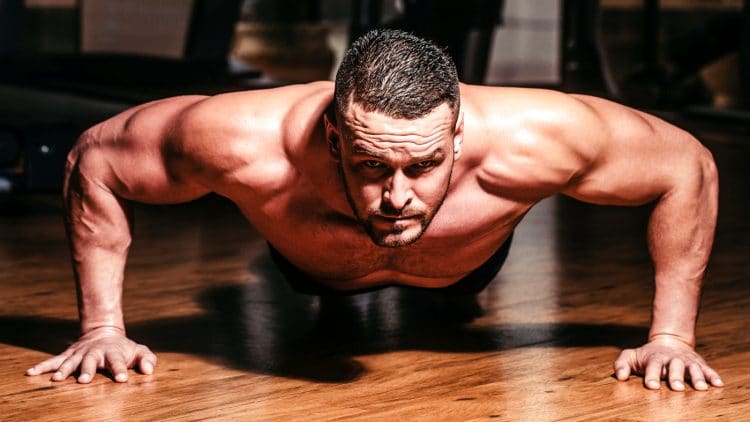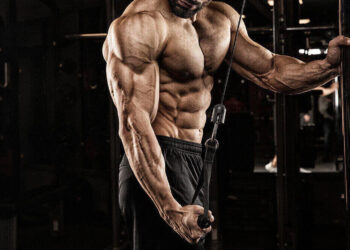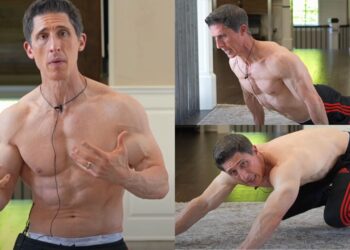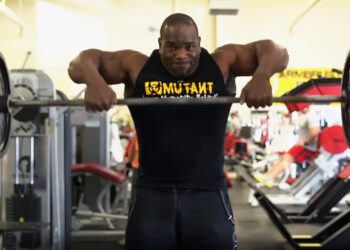Bodybuilding is a time-consuming activity. With so many important muscle groups to train, you can’t afford to waste time on exercises that don’t produce results. Instead, you want every movement in your workouts to be as safe and productive as possible.
With less wasted time, you’ll be able to do more sets of the exercises that DO work and build bigger muscles faster.
But how do you know what exercises are best? After all, most lists of best exercises are based on opinion rather than any kind of empirical measurement. And what works well for one person could be less effective for another.
If you are in a quandary about which exercises are best, we’ve got good news for you. A study by the American Council on Exercise has revealed what they’ve found to be the best chest building exercises.
Using wireless electromyography (EMG), The American Council on Exercise (ACE) and scientists at the University of Wisconsin-LaCrosse measured the activity of the pectoralis major during nine popular chest exercises to determine which one was best.
The ACE study was done using 14 male participants, all of whom had some strength training experience. While this was not a particularly large cohort of subjects, the results may still help you choose which exercises to prioritize when lack-of training time is an issue.
Level Up Your Fitness: Join our 💪 strong community in Fitness Volt Newsletter. Get daily inspiration, expert-backed workouts, nutrition tips, the latest in strength sports, and the support you need to reach your goals. Subscribe for free!
In this article, we reveal the results of the study and how to use this information to build your best pecs ever!
The Best Chest Exercises According to Science
Not sure which exercises are best for building a massive chest? Here, in reverse order, are the nine best chest exercises according to science (1). Including any of these exercises in your upper body workouts should help you sculpt the pecs of your dreams.
Average EMG and RPE for Each Exercise Compared to The Barbell Bench Press
| No | Exercise | Avg. EMG | RPE |
| 1 | Barbell Bench Press | 100 | 6.5 ± 1.98 |
| 2 | Pec Deck Machine | 98 ± 26.4 | 5.4 ± 2.13 |
| 3 | Bent-Forward Cable Crossovers | 93 ± 22.0 | 5.1 ± 1.60 |
| 4 | Chest Press Machine | 79 ± 22.4* | 4.3 ± 2.30* |
| 5 | Inclined Dumbbell Flys | 69 ± 30.5* | 5.0 ± 1.50 |
| 6 | Dips | 69 ± 15.8* | 2.9 ± 2.06* |
| 7 | Suspended Push-ups | 63 ± 18.5* | 3.6 ± 2.22* |
| 8 | Stability Ball Push-ups | 61 ± 20.7* | 2.3 ± 1.72* |
| 9 | Standard Push-ups | 61 ± 20.6* | 1.5 ± 1.15* |
9 – Standard push-up
Almost every exerciser on the planet has done push-ups at some time. From elite athletes to special forces soldiers to MMA fighters to kids in PE class – push-ups are probably the most widely performed exercise in history.
The great thing about push-ups is that you can do them anywhere and anytime as you don’t need any equipment. On the downside, as you get stronger, you’ll end up doing ever-increasing numbers of push-ups, and that could make your workouts less time-efficient.
However, there are lots of challenging push-up variations to try, so your workouts need never be boring. Strapping on a weighted vest is another excellent way to avoid doing high-rep sets.
Learn how to do standard push-ups correctly here.
8 – Stability ball push-up
If you’ve mastered standard push-ups and are looking for your next challenge, give stability ball push-ups a try. This exercise increases pec engagement by introducing an element of instability. It also forces you to push your hands inward to avoid slipping off the ball.
As an added bonus, stability ball push-ups are also a reasonably effective core exercise.
On the downside, the stability ball push-up can be hard on your wrists, so make sure you place your hands on either side of the apex of the ball and not on the top.
Find out more about stability ball push-ups here.
7 – Suspended push-up
Suspension trainers like TRX and gymnastic rings add a whole new dimension to bodyweight training. You have to control the handles through 360 degrees, which increases muscle engagement. Doing push-ups on a suspension trainer also allows you to use a wider range of motion, which also makes them more chest-centric.
The ACE study didn’t specify how high off the ground the handles were suspended but, the more horizontal your body is, the harder this exercise becomes. You can also raise your feet or wear a weighted vest to make this exercise even more challenging.
How to do it:
- Set your suspension trainer handles to the required height.
- Take a handle in each hand, so your palms face inward, i.e., a neutral grip.
- Walk your feet back and into the push-up position with your arms straight. Brace your core and stabilize your arms.
- Bend your arms and lower your chest down between your hands. Your range of motion will depend on your shoulder flexibility and joint health.
- Keep your upper arms close to your sides and your wrists straight.
- Push yourself back up and then, at the top of the rep, shrug your shoulders forward to activate the serratus anterior fully.
- Reset your shoulders and then descend into another rep.
6 – Dips
Before the bench press became the world’s favorite chest exercise, old-school bodybuilders built their pecs with dips. To really hit your pecs hard with dips, you must push your legs out behind you and lean forward. If your body is upright, you’ll end up working your triceps more than your chest.
With practice, you’ll soon find that chest dips are a very effective way to work your pecs using just your body weight.
How to do it:
- Use dipping bars that are wider than shoulder-width apart. The narrower your grip, the less chest engagement there will be.
- Place your hands on the bars with your palms turned inward. Support your weight on straight arms.
- Bend your knees and push your legs and hips as far back as you can. The greater the incline, the more pec activation there will be.
- Bend your arms and descend as far as you can without hurting your shoulders. Get a good stretch in your pecs. Allow your upper arms and elbows to flare outward.
- Extend your elbows and push yourself upward, stopping just short of lockout to keep the tension on your pecs. Push inward as well as down to maximize pec engagement.
- Descend and repeat.
Level Up Your Fitness: Join our 💪 strong community in Fitness Volt Newsletter. Get daily inspiration, expert-backed workouts, nutrition tips, the latest in strength sports, and the support you need to reach your goals. Subscribe for free!
5 – Inclined dumbbell flys
Incline dumbbell flys are a popular freeweight chest isolation exercise. Using an incline bench means this move hits your upper pecs a little more than the rest of your chest. As an isolation exercise, incline dumbbell flys don’t involve your triceps too much, and that’s useful if you want to work your pecs without fatiguing your arms.
The key to getting the most out of incline dumbbell flys is using a moderate weight and NOT using your elbows to lift the weight. All of the movement should come from your shoulders. If you have to press the weight up instead of keeping your arms rigid, your dumbbells are too darn heavy! Less ego = better results from incline dumbbell flys.
Learn how to do inclined dumbbell flys here.
4 – Chest press machine
The main advantage of the chest press machine is that you can train to complete muscular failure without having to worry about getting pinned under a heavy weight. Also, with their dual handles, most chest press machines allow you to use a large range of motion that invariably leads to increased pec engagement.
There are many different chest press machines available, and the ACE study did not reveal which one they used. However, the Hammer chest press and other leverage-type machines usually result in a more intense chest contraction at the top of each rep.
Learn how to use a chest press machine here.
3 – Bent-forward cable crossover
The bent-forward cable crossover, which most people just call cable crossovers, has always been a popular chest exercise. After all, most crossover machines are right in front of a mirror, so you can really see this exercise working.
It turns out that this exercise is not just an ego-booster but a bonafide chest builder, too.
Like dumbbell flys and other chest isolation exercises on this list, you’ll get more from bent-forward cable crossovers if you use moderate weights and perfect form. So, don’t turn this chest isolation movement into a standing press. Instead, dial back the weight and focus on squeezing your pecs to fully engage your pecs.
Read all about cable crossovers in our in-depth guide.
2 – Pec deck machine
A lot of bodybuilders are quick to label the pec deck as a secondary or finishing exercise. And while it can be used for that purpose, the results of the ACE study suggest it could be used as a primary muscle builder as well.
The great thing about the pec deck is that it allows you to train to absolute failure in complete safety, and you can also use it for intensity-boosting drop sets.
Regardless of where you put it in your workouts, it’s clear that the pec deck, and its close relative the machine fly, both deserve a place in your workouts.
How to do it:
- Adjust the seat so that, when you sit on it and grip the handles, your elbows are level with your shoulders, and your upper arms are parallel to the floor. Select a light to moderate weight.
- Sit on the machine and place your feet on the floor or the footrests. Reach up and back and grab the handles. Place your forearms against the arm pads.
- Pull your shoulders down and back and brace your abs.
- Without jerking or leaning forward, smoothly squeeze your arms together until the machine arms touch lightly in front of your chest. Pause for 1-2 seconds.
- Open your arms and return to the starting position, stopping just short of touching the weights together.
- Repeat for the prescribed number of repetitions.
Learn more about the pec deck machine here.
1 – Barbell bench press
It was inevitable that the ACE’s list of best chest exercises would include the bench press. After all, it’s a very popular exercise that features many people’s chest workouts. However, it is surprising that it’s ranked as number one because some training experts believe that it’s a better strength builder than a muscle developer.
In fact, some bodybuilders skip barbell bench presses entirely because they believe the dumbbell version is superior for muscle growth. Legendary bodybuilding coach Vince Gironda was so against this exercise that he banned it from his gym and only allowed people to do guillotine neck presses instead.
Regardless, the science suggests the best exercise for the chest is bench presses. However, because of things like chest depth and arm length, that might not be true for everyone! That said, another study suggested that raising your feet during barbell bench presses would increase chest muscle engagement. So, that may be a way to get even more from this exercise (2).
Learn how to do the barbell bench press here.
More Chest Exercises:
- The Best Chest Exercises You Can Do At Home
- 10 Best Chest Exercises For Building Bigger Pecs
- The Best Inner Chest Workout for Sculpted Pecs
- The 10 Best Dumbbell Chest Exercises
- 7 Best Upper Chest Exercises To Build Strength and Size
- 5 Best TRX Chest Exercises
Wrapping Up
Any of the nine exercises included in the ACE study will help you build a bigger, more muscular chest. There are also several other chest exercises that may be similarly effective but didn’t make it into the study, such as deficit push-ups, dumbbell bench presses, and Gironda neck presses.
However, it seems that, in terms of bang for your buck, barbell bench presses, the pec deck, and cable crossovers are among the best chest builders. The chest press machine, inclined flys, and dips come in close behind.
Building your chest workouts around these exercises should ensure that you get the results you want from your training. However, even though they came out on top, don’t just do these so-called best exercises and forget the rest.
Exercise variety is also important for maintaining training motivation and building muscle, so make sure you include several different exercises in your chest workouts and change exercises from one training cycle to the next.
Finally, make sure you include flat, incline, and decline movements in your chest workout to hit your chest from all the angles. This may even necessitate doing two chest workouts a week.
References:
1 – American Council on Exercise (ACE): What Are the Top 3 Most Effective Chest Exercises? https://www.acefitness.org
2 – PubMed: Evaluation and Comparison of Electromyographic Activity in Bench Press with Feet on The Ground and Active Hip Flexion https://www.ncbi.nlm.nih.gov/pmc/articles/PMC6568408/









